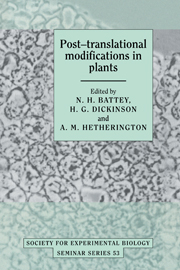Book contents
- Frontmatter
- Contents
- List of contributors
- List of abbreviations
- Preface
- Some roles of post-translational modifications in plants
- Signal transduction and protein phosphorylation in bacteria
- Roles of protein phosphorylation in animal cells
- The significance of post-translational modification of proteins by phosphorylation in the regulation of plant development and metabolism
- Post-translational modification of chloroplast proteins and the regulation of protein turnover
- Purification of a small phosphoprotein from chloroplasts and characterisation of its phosphoryl group
- Use of synthetic peptides to study G proteins and protein kinases within plant cells
- Activation of membrane-associated protein kinase by lipids, its substrates, and its function in signal transduction
- Distribution and function of Ca2+-dependent, calmodulin-independent protein kinases
- Phosphorylation of the plasma membrane proton pump
- The regulation of phosphoenolpyruvate carboxylase by reversible phosphorylation
- Protein phosphorylation and circadian rhythms
- Control of translation by phosphorylation of mRNP proteins in Fucus and Xenopus
- Regulation of plant metabolism by reversible protein (serine/threonine) phosphorylation
- Detection, biosynthesis and some functions of glycans N-linked to plant secreted proteins
- Biosynthesis, intracellular transport and processing of ricin
- Post-translational processing of concanavalin A
- The role of cell surface glycoproteins in differentiation and morphogenesis
- Ubiquitination of proteins during floral development and senescence
- Index
Regulation of plant metabolism by reversible protein (serine/threonine) phosphorylation
Published online by Cambridge University Press: 06 July 2010
- Frontmatter
- Contents
- List of contributors
- List of abbreviations
- Preface
- Some roles of post-translational modifications in plants
- Signal transduction and protein phosphorylation in bacteria
- Roles of protein phosphorylation in animal cells
- The significance of post-translational modification of proteins by phosphorylation in the regulation of plant development and metabolism
- Post-translational modification of chloroplast proteins and the regulation of protein turnover
- Purification of a small phosphoprotein from chloroplasts and characterisation of its phosphoryl group
- Use of synthetic peptides to study G proteins and protein kinases within plant cells
- Activation of membrane-associated protein kinase by lipids, its substrates, and its function in signal transduction
- Distribution and function of Ca2+-dependent, calmodulin-independent protein kinases
- Phosphorylation of the plasma membrane proton pump
- The regulation of phosphoenolpyruvate carboxylase by reversible phosphorylation
- Protein phosphorylation and circadian rhythms
- Control of translation by phosphorylation of mRNP proteins in Fucus and Xenopus
- Regulation of plant metabolism by reversible protein (serine/threonine) phosphorylation
- Detection, biosynthesis and some functions of glycans N-linked to plant secreted proteins
- Biosynthesis, intracellular transport and processing of ricin
- Post-translational processing of concanavalin A
- The role of cell surface glycoproteins in differentiation and morphogenesis
- Ubiquitination of proteins during floral development and senescence
- Index
Summary
Introduction: intracellular signalling in plant cells
Plants are able to detect and respond quickly to environmental stimuli. For example, dramatic changes in intracellular metabolism and leaf orientation occur in plants, in response to changing light conditions, that allow them to optimise their ability to harvest energy from the sun at all times of the day. Many plants are disease-resistant because they are able to detect fungal attack and respond by mounting a battery of chemical defences.
Other potential routes for signalling pathways in plant cells are those emanating from specialised internal regulators of timed events such as cell cycle or circadian rhythms (often called ‘internal clocks’). There may also be regulatory networks controlling exchange of information between different cellular compartments (e.g. between chloroplast and cytoplasm) which might be mediated by metabolites or by specialised signal molecules.
It is becoming increasingly clear that, as in animal cells (see Hardie, this volume), changes in intracellular protein (serine/threonine) phosphorylation in plants are central in transduction of extracellular signals, in control of the cell cycle and circadian rhythms and in internal metabolic control of cells (Fig. 1).
It is the critical property of the reversibility of intracellular protein phosphorylation which suits this mechanism for its role in ‘switching’ activities of target proteins from one steady state to another and allows for great sensitivity of control and integration of cellular regulation. Therefore, control of protein phosphatase activity is just as important as control of the protein kinases.
- Type
- Chapter
- Information
- Post-translational Modifications in Plants , pp. 197 - 212Publisher: Cambridge University PressPrint publication year: 1993
- 8
- Cited by

